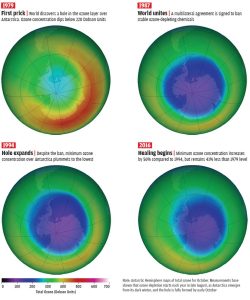16 Sep HAPPY OZONE DAY : OZONE FOR LIFE
HAPPY OZONE DAY: OZONE FOR LIFE
Context: 16th September is recognized as world ozone day, celebrated worldwide with more cheers, and this year(2022) the Montreal protocol is 35 years old. This article talks about how the O3 layer impacts World’s environment and climate change.
WORLD OZONE DAY
In 1994, the United Nations General Assembly accepted the proposal to celebrate the 16th of September as Ozone day to mark the day of the signing of the Montreal Protocol. Since then the day has been celebrated with enthusiasm across the world to beat the depletion of our O3.
WHAT IS OZONE DEPLETION?
It is the process of breaking down atmospheric/stratospheric ozone (O3). The process is quite dominant at the south pole (above Antarctica). The commonly identified depletion is halogenetic compounds ( bromine, chlorine, fluorine). Brominated compounds have more potential than chlorinated (CFCs). The man-made pollutants and chemicals identified as depletion are-
- Methyl bromide,
- Methyl chloroform,
- Carbon tetrachloride and
- families of chemicals known as halons, chlorofluorocarbons (CFCs), and hydrochlorofluorocarbons (HCFCs)
THE HISTORY BEHIND THE MOST SUCCESSFUL TREATY
With the advent of industrialization and massive urbanization in the developed world and later in the developing world, the earth started to show adverse consequences of uncontrolled and unrestricted growth. With more research and understanding of the symptoms (floods, cyclones, droughts, etc) later many buzzwords came to the front like global warming, the greenhouse effect, and O3 depletion.
The world was at a common agreement to control the menace the overall humanity is facing and thus, in 1985, with much more debate and discussions Vienna convention for the protection of the O3 layer was finalized. Later, in 1987, the Montreal Protocol was signed with clearer and defined targets with commitments from all world countries.
THE MONTREAL PROTOCOL: MOST SUCCESSFUL GLOBAL TREATY
On 16th Sept 1987 the treaty was signed by countries and accepted in letter and spirit. It sets the target for the phased reduction of Chlorofluorocarbons (CFCs) in use. It is one of the most successful global treaties on the count as ratified by every country in the world in 2009 (UN Website). It has successfully removed the use of CFCs except in some essential health and industrial equipment. Later in 1992, the phased reductions of the Hydrochlorofluorocarbons were also targeted with different timelines for developed and developing countries.

Pic: Ozone for Life
KIGALI AGREEMENT A BOOST
In 2019, the world again agreed to totally phase out the HCFCs which were allowed as a transition to switch from CFCs as there was no immediate alternative available. But later it was realized that HCFCs are though not significantly contributing to O3 depletion but are contributors to greenhouse gases. Thus, the Kigali agreement was ratified to finally phase out the use of HCFCs with some concessions to the developing countries, by 2045.
THE RESULT IS ROCKING
The combined effect of phasing out of hologenetic-depleting compounds is so cheerful. The recovery of the O3 has been registered by scientists. Scientists predict that the ozone-depleting process has been averted successfully. The O3 will recover to the pre-1980 level by 2070.
THE LEARNINGS FROM THE STORY
The ozone-depleting episode has brought humanity a common platform and signified the need to discuss critical issues. Its successful predicted aversion shows that when science supports combined efforts and common will converges nothing is impossible for the global community.
We should be thankful for the O3 and the Montreal protocol that has given us a chance to realize our true potential. Its success not only lies in controlling O3 depletion but reversing all threats humanity is facing now and in the future.
Download PDF Now:
Plutus IAS current affairs eng med 16th Sep 2022
Source:
IAS Current Affairs
Acquire general knowledge by reading daily current affairs for the UPSC examination from Plutus IAS. So visit our site to get the best and most summarized current affairs for the UPSC examination.
Also, read Weekly and Monthy current affairs for the IAS examination from our site:



No Comments